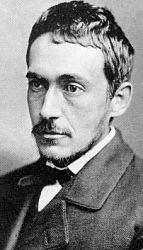
|
Born in Philadelphia on July 25, 1844, Eakins studied drawing at the Pennsylvania Academy of the Fine Arts from 1861 to 1866. His concurrent study of anatomy at Jefferson Medical College led to a lifelong interest in scientific realism. Eakins spent three years in Paris from 1866 to 1869, where he studied at the ęcole des Beaux-Arts. He was strongly influenced by 17th-century masters, particularly the Dutch artist Rembrandt and the Spanish painters Josepe de Ribera and Diego Velazquez. These masters impressed him with their realism and psychological penetration. He returned to Philadelphia in 1870 and lived there the rest of his life.
Eakins's paintings depict scenes and people observed in the life around him in Philadelphia, particularly domestic scenes of his family and friends. He exercised his scientific inclination in paintings of sailing, rowing, and hunting, where he delineated the anatomy of the human body in motion. He painted several large and powerful hospital scenes, most notably The Gross Clinic (1875, Jefferson Medical College, Philadelphia), which combined sharp realism—a depiction of an operation in progress—with psychological acuity in the portrayal of the surgeon, Doctor Gross.
As director of the Pennsylvania Academy of the Fine Arts, Eakins introduced an innovative curriculum,including thorough study of anatomy and dissection as well as scientific perspective, which revolutionized the teaching of art in America. His insistence on study from the nude scandalized the school's authorities, however, and he was forced to resign in 1886.
During the later part of his career, Eakins's scientific interests were overshadowed by his preoccupation with psychology and personality, and in his art he concentrated principally on portraiture—studies of friends, scientists, musicians, artists, and clergymen. In addition to their masterly evocation of personality, these portraits are characterized by uncompromising realism and by a sculptural sense of form, which is evident in the strong modeling of the sitters' heads, bodies, and hands. Typical of his full-length portraits is The Pathetic Song (1881, Corcoran Gallery of Art, Washington, D.C.), with the standing figure of a singer in a rich silk gown silhouetted against a dimly lighted music room.
Although none of his paintings brought him financial or popular success, Eakins had a profound influence, both as a painter and as a teacher, on the course of American naturalism. His realistic approach to painting was ahead of his time. He died in Philadelphia on June 25, 1916.
|

